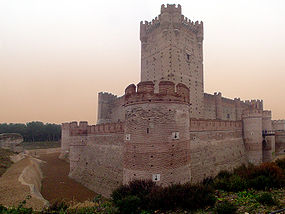
Monument (Spain)
Encyclopedia
The current legislation regarding historical monuments in Spain dates from 1985. However, Monumentos nacionales (to use the pre-1985 term) were first designated in the nineteenth century. It was originally a fairly broad category for national heritage sites protecting, for example, the Alhambra
. The overarching category for Spanish heritage sites is now Bien de Interés Cultural
(Heritage of cultural interest).
 Now there are some 13,000 monuments registered by the Ministry of Culture within the wider category of Bien de Interés Cultural.
Now there are some 13,000 monuments registered by the Ministry of Culture within the wider category of Bien de Interés Cultural.
As well as monuments, the category of Bien de Interés Cultural includes the following sub-categories of non-movable heritage:
In some cases there is a degree of overlap between these sub-categories. For example, the Celtiberian
site of Numantia
is protected as a monument and archaeological zone.
Alhambra
The Alhambra , the complete form of which was Calat Alhambra , is a palace and fortress complex located in the Granada, Andalusia, Spain...
. The overarching category for Spanish heritage sites is now Bien de Interés Cultural
Bien de Interés Cultural
A Bien de Interés Cultural is a category of the Spanish heritage register. This category dates from 1985 when it replaced the former heritage category of Monumento nacional in order to extend protection to a wider range of cultural property...
(Heritage of cultural interest).

As well as monuments, the category of Bien de Interés Cultural includes the following sub-categories of non-movable heritage:
- Conjunto histórico, a type of conservation area (which may include one or more monuments).
- Jardín históricoJardín históricoJardín histórico means "historic garden" in Spanish, and is a term applied to a number of gardens in Spanish-speaking countries.In Spain Jardín histórico is a heritage listing which protects historic gardens...
, historic garden (for example the gardens of AranjuezAranjuezAranjuez is a town lying 48 km south of Madrid, in the southern part of the Community of Madrid. It is located at the confluence of the Tagus and Jarama rivers, 48 km from Toledo. As of 2009, it has a population of 54,055.-History:...
) - Sitio histórico (for example the Bulls of GuisandoBulls of GuisandoThe Bulls of Guisando are a set of celtiberian sculptures located on the hill of Guisando in the municipality of El Tiemblo, Ávila, Spain. The sculptures, made of granite, represent quadrupeds identified as bulls or pigs...
) - Zona arqueológica, archaeological zone (for example the Archaeological Site of Atapuerca)
In some cases there is a degree of overlap between these sub-categories. For example, the Celtiberian
Celtiberians
The Celtiberians were Celtic-speaking people of the Iberian Peninsula in the final centuries BC. The group used the Celtic Celtiberian language.Archaeologically, the Celtiberians participated in the Hallstatt culture in what is now north-central Spain...
site of Numantia
Numantia
Numantia is the name of an ancient Celtiberian settlement, whose remains are located 7 km north of the city of Soria, on a hill known as Cerro de la Muela in the municipality of Garray....
is protected as a monument and archaeological zone.
See also
A few of numerous articles at Wikipedia covering Spanish monuments are:- NumantiaNumantiaNumantia is the name of an ancient Celtiberian settlement, whose remains are located 7 km north of the city of Soria, on a hill known as Cerro de la Muela in the municipality of Garray....
(designated 1882, and protection enhanced by a Zona Arqueológica in 1999) - Castle of La MotaCastle of La Motathumb|250px|Side view.The Castle of the La Mota or Castillo de La Mota is a reconstructed medieval fortress, located in the town of Medina del Campo, province of Valladolid, Spain. It is so named because of its location on an elevated hill, a mota, from where it dominates the town and surrounding...
(1904) - Cuéllar CastleCuéllar CastleCuéllar Castle or The Castle of the Dukes of Alburquerque is the most emblematic monument in the town of Cuéllar, located in the province of Segovia, autonomous community of Castile and León, in Spain...
(1931) - San Sebastian Church, MadridSan Sebastian Church, MadridThe Saint Sebastian Church or Iglesia de San Sebastián is a 16th century church in central Madrid, Spain. It is located on Atocha street, #39. The name arises from a devotional chapel which was found along the route to the Basilica of Nuestra Señora de Atocha, founded in 1541...
(1969) - San Cayetano Church, MadridSan Cayetano Church, MadridThe Church of Saint Cajetan, known as the church of San Millán y San Cayetano is a Baroque church in Madrid, Spain.- History :The present church was built adjacent to the now absent Convent of Nuestra Señora del Favor . It was built at the site of an oratory dedicated to St...
(1980)

